Licheng Jiao
SoccerNet 2025 Challenges Results
Aug 26, 2025Abstract:The SoccerNet 2025 Challenges mark the fifth annual edition of the SoccerNet open benchmarking effort, dedicated to advancing computer vision research in football video understanding. This year's challenges span four vision-based tasks: (1) Team Ball Action Spotting, focused on detecting ball-related actions in football broadcasts and assigning actions to teams; (2) Monocular Depth Estimation, targeting the recovery of scene geometry from single-camera broadcast clips through relative depth estimation for each pixel; (3) Multi-View Foul Recognition, requiring the analysis of multiple synchronized camera views to classify fouls and their severity; and (4) Game State Reconstruction, aimed at localizing and identifying all players from a broadcast video to reconstruct the game state on a 2D top-view of the field. Across all tasks, participants were provided with large-scale annotated datasets, unified evaluation protocols, and strong baselines as starting points. This report presents the results of each challenge, highlights the top-performing solutions, and provides insights into the progress made by the community. The SoccerNet Challenges continue to serve as a driving force for reproducible, open research at the intersection of computer vision, artificial intelligence, and sports. Detailed information about the tasks, challenges, and leaderboards can be found at https://www.soccer-net.org, with baselines and development kits available at https://github.com/SoccerNet.
Self-similarity Analysis in Deep Neural Networks
Jul 23, 2025Abstract:Current research has found that some deep neural networks exhibit strong hierarchical self-similarity in feature representation or parameter distribution. However, aside from preliminary studies on how the power-law distribution of weights across different training stages affects model performance,there has been no quantitative analysis on how the self-similarity of hidden space geometry influences model weight optimization, nor is there a clear understanding of the dynamic behavior of internal neurons. Therefore, this paper proposes a complex network modeling method based on the output features of hidden-layer neurons to investigate the self-similarity of feature networks constructed at different hidden layers, and analyzes how adjusting the degree of self-similarity in feature networks can enhance the classification performance of deep neural networks. Validated on three types of networks MLP architectures, convolutional networks, and attention architectures this study reveals that the degree of self-similarity exhibited by feature networks varies across different model architectures. Furthermore, embedding constraints on the self-similarity of feature networks during the training process can improve the performance of self-similar deep neural networks (MLP architectures and attention architectures) by up to 6 percentage points.
Meta knowledge assisted Evolutionary Neural Architecture Search
Apr 30, 2025Abstract:Evolutionary computation (EC)-based neural architecture search (NAS) has achieved remarkable performance in the automatic design of neural architectures. However, the high computational cost associated with evaluating searched architectures poses a challenge for these methods, and a fixed form of learning rate (LR) schedule means greater information loss on diverse searched architectures. This paper introduces an efficient EC-based NAS method to solve these problems via an innovative meta-learning framework. Specifically, a meta-learning-rate (Meta-LR) scheme is used through pretraining to obtain a suitable LR schedule, which guides the training process with lower information loss when evaluating each individual. An adaptive surrogate model is designed through an adaptive threshold to select the potential architectures in a few epochs and then evaluate the potential architectures with complete epochs. Additionally, a periodic mutation operator is proposed to increase the diversity of the population, which enhances the generalizability and robustness. Experiments on CIFAR-10, CIFAR-100, and ImageNet1K datasets demonstrate that the proposed method achieves high performance comparable to that of many state-of-the-art peer methods, with lower computational cost and greater robustness.
Lightweight Adapter Learning for More Generalized Remote Sensing Change Detection
Apr 28, 2025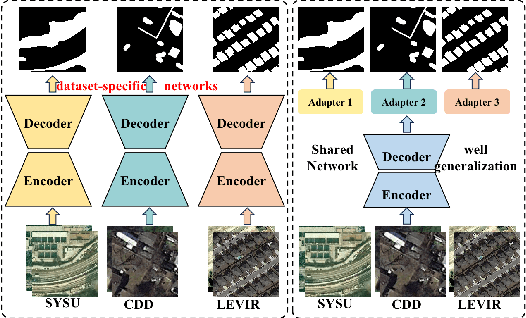

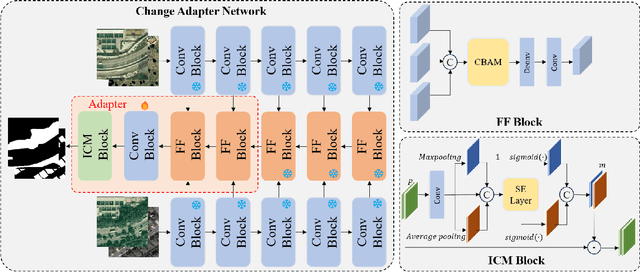
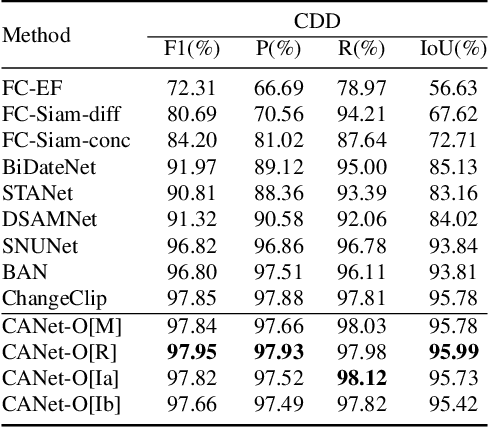
Abstract:Deep learning methods have shown promising performances in remote sensing image change detection (CD). However, existing methods usually train a dataset-specific deep network for each dataset. Due to the significant differences in the data distribution and labeling between various datasets, the trained dataset-specific deep network has poor generalization performances on other datasets. To solve this problem, this paper proposes a change adapter network (CANet) for a more universal and generalized CD. CANet contains dataset-shared and dataset-specific learning modules. The former explores the discriminative features of images, and the latter designs a lightweight adapter model, to deal with the characteristics of different datasets in data distribution and labeling. The lightweight adapter can quickly generalize the deep network for new CD tasks with a small computation cost. Specifically, this paper proposes an interesting change region mask (ICM) in the adapter, which can adaptively focus on interested change objects and decrease the influence of labeling differences in various datasets. Moreover, CANet adopts a unique batch normalization layer for each dataset to deal with data distribution differences. Compared with existing deep learning methods, CANet can achieve satisfactory CD performances on various datasets simultaneously. Experimental results on several public datasets have verified the effectiveness and advantages of the proposed CANet on CD. CANet has a stronger generalization ability, smaller training costs (merely updating 4.1%-7.7% parameters), and better performances under limited training datasets than other deep learning methods, which also can be flexibly inserted with existing deep models.
ACMamba: Fast Unsupervised Anomaly Detection via An Asymmetrical Consensus State Space Model
Apr 16, 2025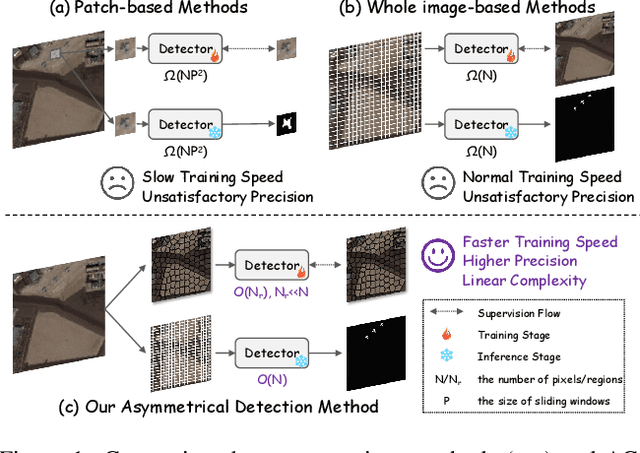
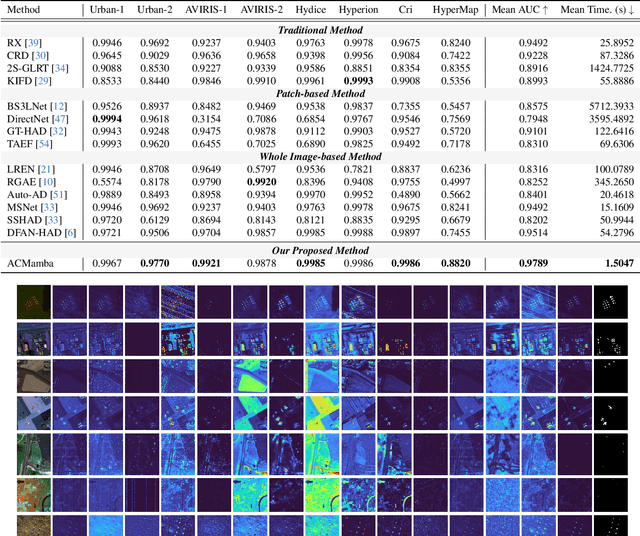
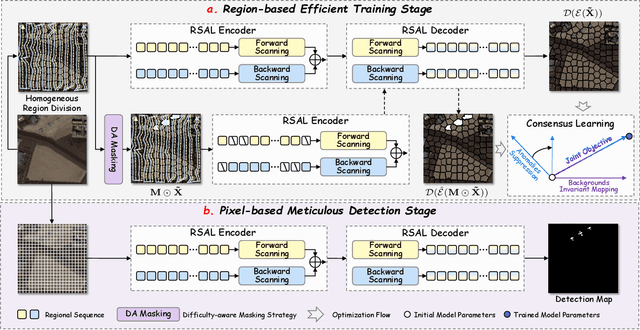
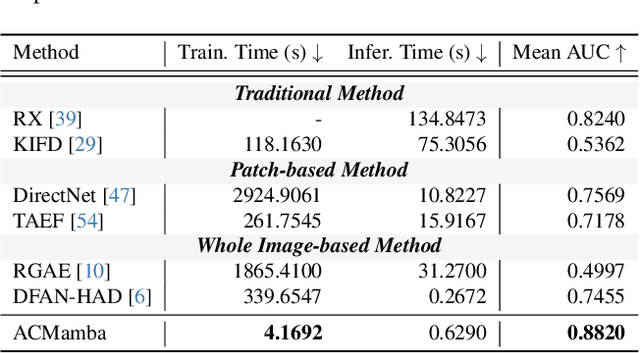
Abstract:Unsupervised anomaly detection in hyperspectral images (HSI), aiming to detect unknown targets from backgrounds, is challenging for earth surface monitoring. However, current studies are hindered by steep computational costs due to the high-dimensional property of HSI and dense sampling-based training paradigm, constraining their rapid deployment. Our key observation is that, during training, not all samples within the same homogeneous area are indispensable, whereas ingenious sampling can provide a powerful substitute for reducing costs. Motivated by this, we propose an Asymmetrical Consensus State Space Model (ACMamba) to significantly reduce computational costs without compromising accuracy. Specifically, we design an asymmetrical anomaly detection paradigm that utilizes region-level instances as an efficient alternative to dense pixel-level samples. In this paradigm, a low-cost Mamba-based module is introduced to discover global contextual attributes of regions that are essential for HSI reconstruction. Additionally, we develop a consensus learning strategy from the optimization perspective to simultaneously facilitate background reconstruction and anomaly compression, further alleviating the negative impact of anomaly reconstruction. Theoretical analysis and extensive experiments across eight benchmarks verify the superiority of ACMamba, demonstrating a faster speed and stronger performance over the state-of-the-art.
PVUW 2025 Challenge Report: Advances in Pixel-level Understanding of Complex Videos in the Wild
Apr 15, 2025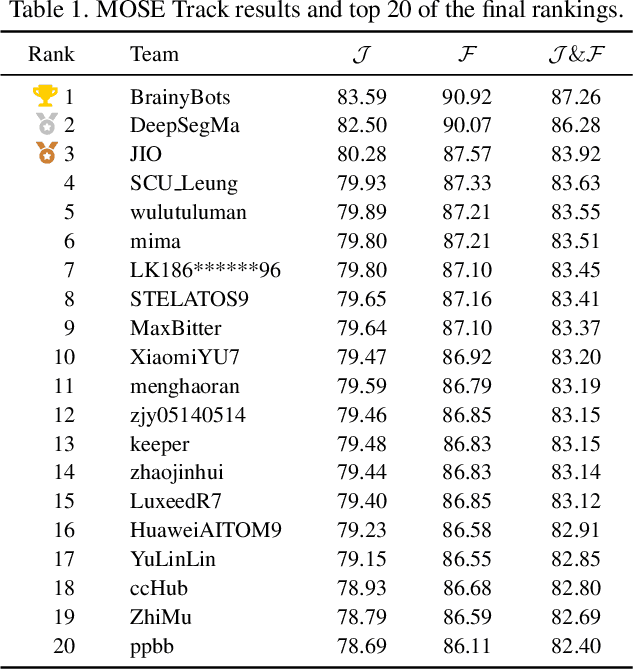
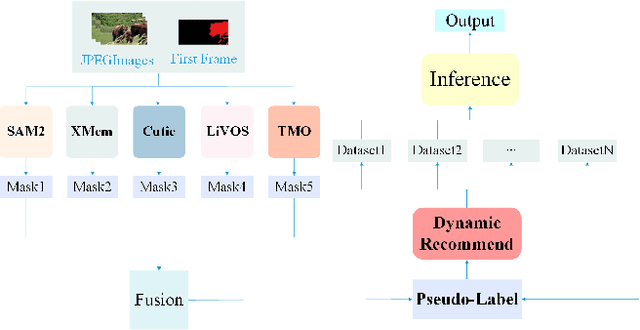
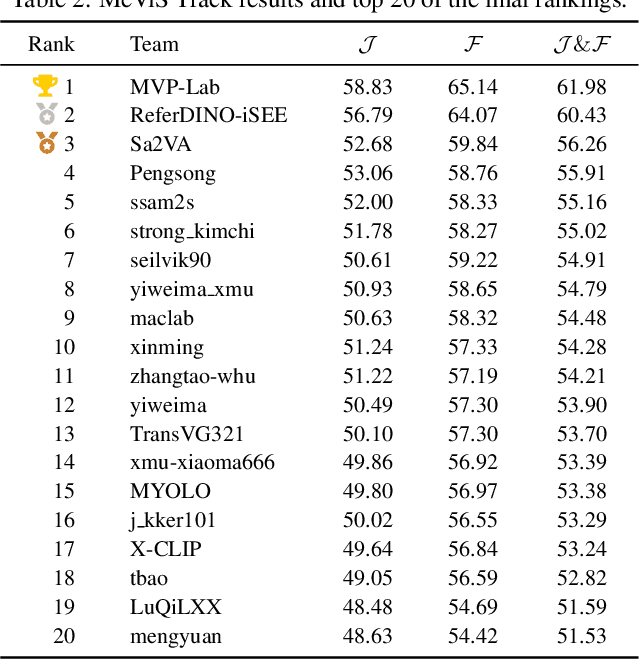
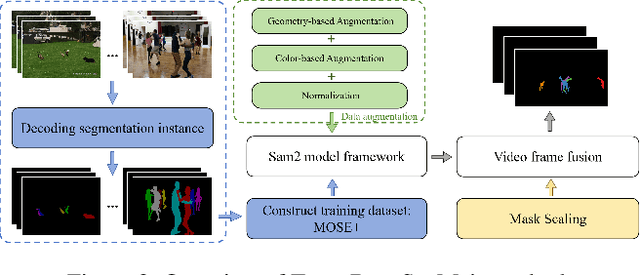
Abstract:This report provides a comprehensive overview of the 4th Pixel-level Video Understanding in the Wild (PVUW) Challenge, held in conjunction with CVPR 2025. It summarizes the challenge outcomes, participating methodologies, and future research directions. The challenge features two tracks: MOSE, which focuses on complex scene video object segmentation, and MeViS, which targets motion-guided, language-based video segmentation. Both tracks introduce new, more challenging datasets designed to better reflect real-world scenarios. Through detailed evaluation and analysis, the challenge offers valuable insights into the current state-of-the-art and emerging trends in complex video segmentation. More information can be found on the workshop website: https://pvuw.github.io/.
DiffMOD: Progressive Diffusion Point Denoising for Moving Object Detection in Remote Sensing
Apr 14, 2025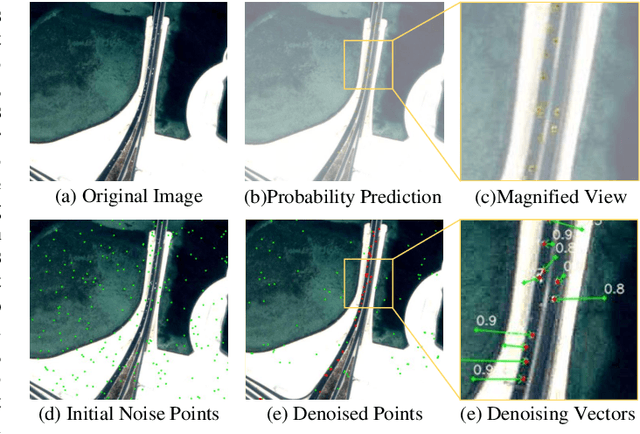
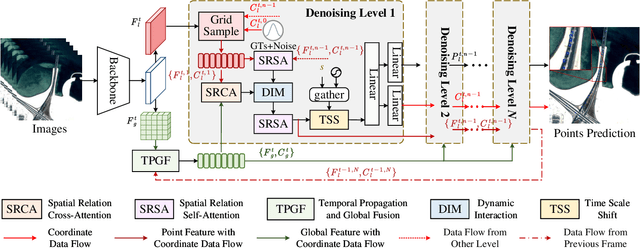
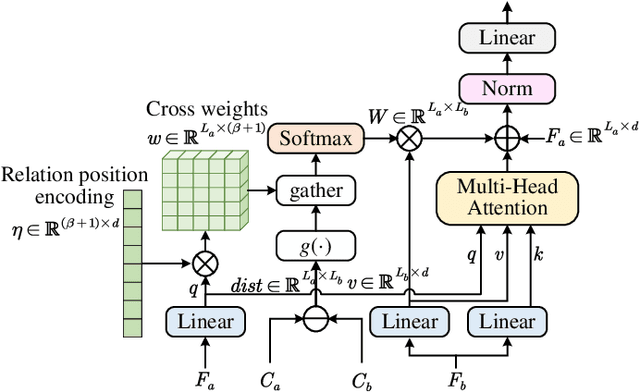
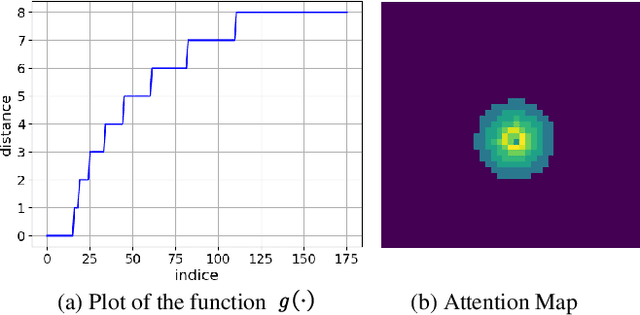
Abstract:Moving object detection (MOD) in remote sensing is significantly challenged by low resolution, extremely small object sizes, and complex noise interference. Current deep learning-based MOD methods rely on probability density estimation, which restricts flexible information interaction between objects and across temporal frames. To flexibly capture high-order inter-object and temporal relationships, we propose a point-based MOD in remote sensing. Inspired by diffusion models, the network optimization is formulated as a progressive denoising process that iteratively recovers moving object centers from sparse noisy points. Specifically, we sample scattered features from the backbone outputs as atomic units for subsequent processing, while global feature embeddings are aggregated to compensate for the limited coverage of sparse point features. By modeling spatial relative positions and semantic affinities, Spatial Relation Aggregation Attention is designed to enable high-order interactions among point-level features for enhanced object representation. To enhance temporal consistency, the Temporal Propagation and Global Fusion module is designed, which leverages an implicit memory reasoning mechanism for robust cross-frame feature integration. To align with the progressive denoising process, we propose a progressive MinK optimal transport assignment strategy that establishes specialized learning objectives at each denoising level. Additionally, we introduce a missing loss function to counteract the clustering tendency of denoised points around salient objects. Experiments on the RsData remote sensing MOD dataset show that our MOD method based on scattered point denoising can more effectively explore potential relationships between sparse moving objects and improve the detection capability and temporal consistency.
STSeg-Complex Video Object Segmentation: The 1st Solution for 4th PVUW MOSE Challenge
Apr 11, 2025

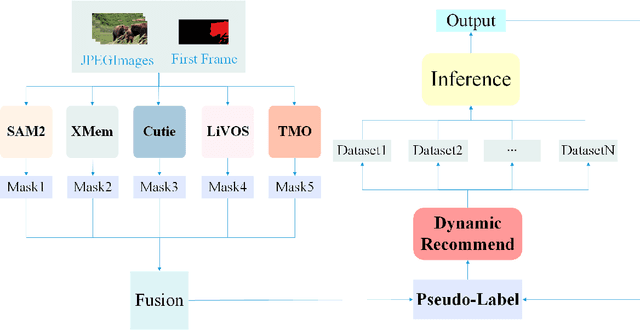

Abstract:Segmentation of video objects in complex scenarios is highly challenging, and the MOSE dataset has significantly contributed to the development of this field. This technical report details the STSeg solution proposed by the "imaplus" team.By finetuning SAM2 and the unsupervised model TMO on the MOSE dataset, the STSeg solution demonstrates remarkable advantages in handling complex object motions and long-video sequences. In the inference phase, an Adaptive Pseudo-labels Guided Model Refinement Pipeline is adopted to intelligently select appropriate models for processing each video. Through finetuning the models and employing the Adaptive Pseudo-labels Guided Model Refinement Pipeline in the inference phase, the STSeg solution achieved a J&F score of 87.26% on the test set of the 2025 4th PVUW Challenge MOSE Track, securing the 1st place and advancing the technology for video object segmentation in complex scenarios.
Generalization-aware Remote Sensing Change Detection via Domain-agnostic Learning
Apr 01, 2025Abstract:Change detection has essential significance for the region's development, in which pseudo-changes between bitemporal images induced by imaging environmental factors are key challenges. Existing transformation-based methods regard pseudo-changes as a kind of style shift and alleviate it by transforming bitemporal images into the same style using generative adversarial networks (GANs). However, their efforts are limited by two drawbacks: 1) Transformed images suffer from distortion that reduces feature discrimination. 2) Alignment hampers the model from learning domain-agnostic representations that degrades performance on scenes with domain shifts from the training data. Therefore, oriented from pseudo-changes caused by style differences, we present a generalizable domain-agnostic difference learning network (DonaNet). For the drawback 1), we argue for local-level statistics as style proxies to assist against domain shifts. For the drawback 2), DonaNet learns domain-agnostic representations by removing domain-specific style of encoded features and highlighting the class characteristics of objects. In the removal, we propose a domain difference removal module to reduce feature variance while preserving discriminative properties and propose its enhanced version to provide possibilities for eliminating more style by decorrelating the correlation between features. In the highlighting, we propose a cross-temporal generalization learning strategy to imitate latent domain shifts, thus enabling the model to extract feature representations more robust to shifts actively. Extensive experiments conducted on three public datasets demonstrate that DonaNet outperforms existing state-of-the-art methods with a smaller model size and is more robust to domain shift.
EgoSplat: Open-Vocabulary Egocentric Scene Understanding with Language Embedded 3D Gaussian Splatting
Mar 14, 2025
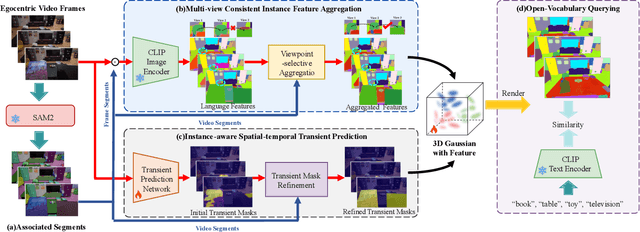

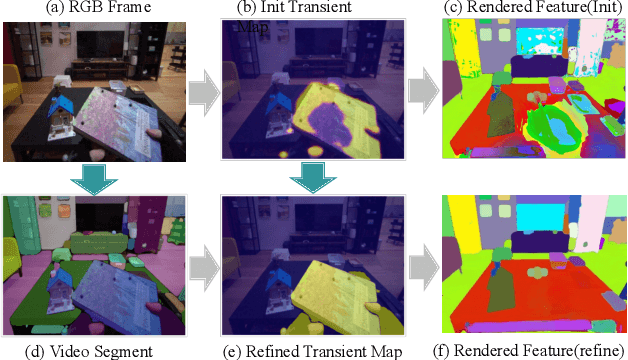
Abstract:Egocentric scenes exhibit frequent occlusions, varied viewpoints, and dynamic interactions compared to typical scene understanding tasks. Occlusions and varied viewpoints can lead to multi-view semantic inconsistencies, while dynamic objects may act as transient distractors, introducing artifacts into semantic feature modeling. To address these challenges, we propose EgoSplat, a language-embedded 3D Gaussian Splatting framework for open-vocabulary egocentric scene understanding. A multi-view consistent instance feature aggregation method is designed to leverage the segmentation and tracking capabilities of SAM2 to selectively aggregate complementary features across views for each instance, ensuring precise semantic representation of scenes. Additionally, an instance-aware spatial-temporal transient prediction module is constructed to improve spatial integrity and temporal continuity in predictions by incorporating spatial-temporal associations across multi-view instances, effectively reducing artifacts in the semantic reconstruction of egocentric scenes. EgoSplat achieves state-of-the-art performance in both localization and segmentation tasks on two datasets, outperforming existing methods with a 8.2% improvement in localization accuracy and a 3.7% improvement in segmentation mIoU on the ADT dataset, and setting a new benchmark in open-vocabulary egocentric scene understanding. The code will be made publicly available.
 Add to Chrome
Add to Chrome Add to Firefox
Add to Firefox Add to Edge
Add to Edge